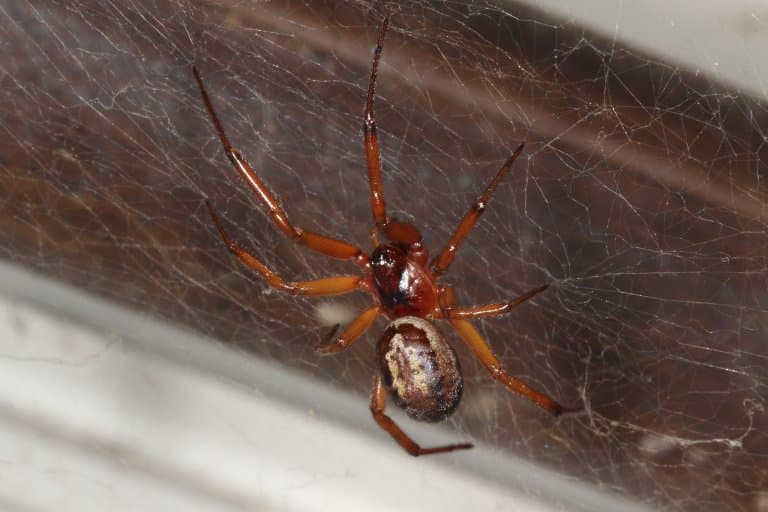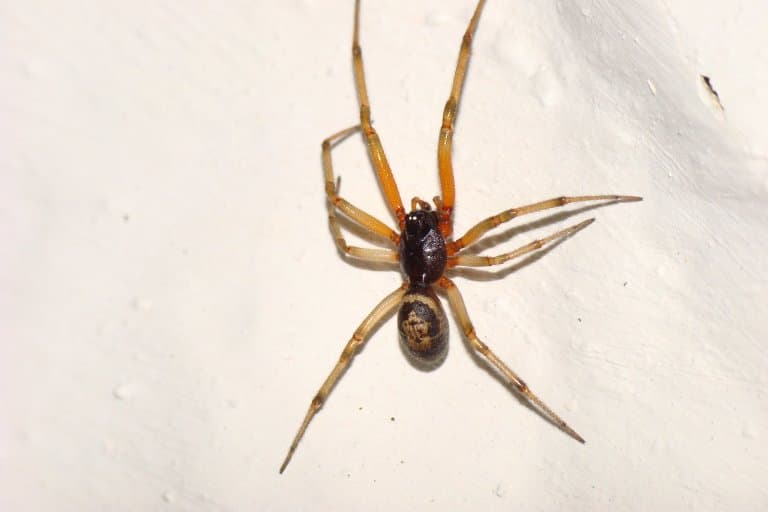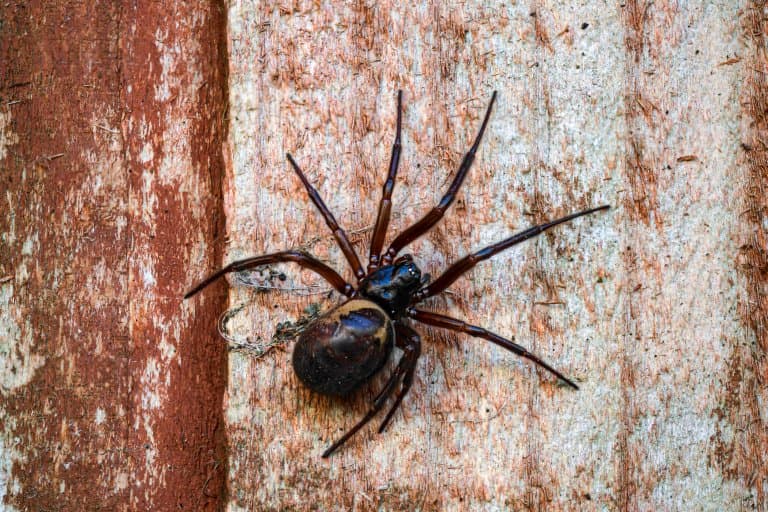False Widow Spider Profile
Black Widow spiders are well known for their dangerous bite. Though they’re not aggressive and can be handled quite comfortably, an accidental interaction with one can make a person very sick for many days.
However, for most people, these are iconic, almost legendary terrors from distant lands. False widow spiders, on the other hand, might be sitting a lot closer.

False Widow Spider Facts Overview
| Habitat: | Dark, sheltered locations in gardens, rabbit hutches, under your bed |
| Location: | Across the UK, Europe , Asia, and the Americas |
| Lifespan: | Around 2 years |
| Size: | Up to 1.5 cm body length |
| Weight: | <1g |
| Color: | Light Brown to black |
| Diet: | Mostly flying insects, sometimes lizards and shrews, bats |
| Predators: | Birds, bats, lizards |
| Top Speed: | Sedentary |
| No. of Species: |
7+ |
| Conservation Status: |
Varied |
The trouble with scary things is that nobody wants to look closely at them.
Those who do dare to study spiders on the regular will know exactly what is and isn’t a black widow, but several species are commonly mistaken for one by those too nervous to get close, and many look nothing like the iconic black widow.
They are often simply a case of mistaken identity and these spiders are often referred to as ‘false widow spiders’. Despite looking vaguely similar dangerous black widows, all these spiders might be able to do is give you a relatively harmless bite.
Interesting False Widow Spider Facts
1. They’re similar in some ways
To be fair, all species of false widow spiders occupy the same family as the black widow: Theridiidae.
So, they do bear some family resemblance, but there are more than 3,000 spiders in this family, so there’s still room for a bit of diversity.
Most of the spiders found in your house will be in this family; in fact, this is the most common arthropod found in human dwellings all over the world.
Theridiidae are commonly known as tangle web spiders, and, like the black widow, all of its stunt-doubles build a mass of sticky web, which separates them from the much neater orb weavers like the garden spiders who make the classic geometric shapes. 1

2. There are many species of false widow, with varying degrees of resemblance
The most common spiders referred to as false widows are the rabbit hutch spider, Steatoda bipunctata); the cupboard spider, Steatoda grossa; and the noble false widow (Steatoda nobilis).
These presumably enjoy setting up shop in rabbit hutches, cupboards and castles, respectively. The latter species is by far the most formally considered the false widow, and are the largest of the three.
Then, there are three other spiders that people commonly get confused with the black widow: Steatoda albomaculata, Steatoda triangulosa and Asagena phalerata, which isn’t even in the same genus.
And these are just the most common.
More or less anything small and dark with an untidy web will scare the pants of some people, despite being in a country 5,000 miles from the habitat of the Black Widow spider.
3. They bite
That’s not to say these ones are all entirely harmless.
All spiders are venomous to some degree, it’s sort of what they do. But most have fangs that are too small to penetrate the skin, and those who can, usually don’t have anything significant to impart.
In the UK, there are around 12 species that are commonly known to be able to bite a person. Some of these are false widows, for example.
And while they are venomous, the venom isn’t usually thought to be dangerous. But the false widows can still pack a punch.
The Noble False Widow bite is said to cause prolonged moderate to intense pain, swelling and erythema, sweating, facial flushing, feverishness, and minor necrosis at the site.

4. They can also get infected
There are some horror stories of UK spider bites damaging tissues and causing all kinds of unsightly things like rotting flesh, and while these are likely just false, there’s a chance that some of them come from the secondary infections that often come with a spider bite.
Our noble friend in particular is associated with such a problem. 11 bacteria strains have been isolated from the mouthparts of the noble false widow, and in one unverified report, there may have been a single death attributed to a bacterial infection as a result of a false widow bite.
But this is all the very worst-case scenario. Again, even black widows are so docile they can be picked up, and when they do bite out of provocation, very few people die from it. False widows are far less dangerous still. 2
5. They’re invaders
As a potentially dangerous animal, Noble false widows don’t really fit in with the rest of the British wildlife – the most threatening of which being a particularly excited goose.
And this is, in part, because they are originally from the Canary Islands. It’s a recent addition to the European fauna and has spread across the world inside people’s luggage and cargo.
They’re fast to reproduce and can eat other spiders, which contributes to their success as an invasive species.
The pattern on noble false widow bodies is ‘skull-shaped’, which doesn’t help their negative reputation either!

6. They’re exceptionally hardy
One of the reasons these spiders have become so successful is their ability to withstand a range of weather conditions and substrates.
They’ll nest up in houses, barns, gardens, roadsides, and abandoned boots. And they’ll do this at any time of the year. They are one of the most invasive spider species known. 3
7. One species deserves the name
Steatoda paykulliana, the Mediterranean false widow, is arguably the only spider of the bunch that actually looks remotely like a false widow. This is a glossy black spider with a red stripe and fits the size profile too.
This one seems to have a similar venom effect to the black widow, but is again less dangerous.
8. They do have the tenacity of a black widow
Black widows are known for tackling prey many times their size in enormous, sticky webs. And in at least one documented case, a Noble false widow was photographed gorging on a pygmy shrew.
This is a mammal that’s tens of times the spider’s weight, but a simple matter to envenomate and liquidise for the spider!

False Widow Spider Fact-File Summary
Scientific Classification
| Kingdom: | Animalia |
| Phylum: | Arthropoda |
| Class: | Arachnida |
| Order: | Aranaea |
| Family: | Theridiidae |
| Genus: | Steatoda, Asagena |
Fact Sources & References
- Misha Leong et al (2017), “The Habitats Humans Provide: Factors affecting the diversity and composition of arthropods in houses“, PMC.
- John P. Dunbar et al (2020), “Synanthropic spiders, including the global invasive noble false widow Steatoda nobilis, are reservoirs for medically important and antibiotic resistant bacteria“, Nature.com.
- Michel Dugon & John Dunbar (2023), “Noble false widows: the tiny spiders taking a big bite out of British and Irish wildlife“, The Conversation.
